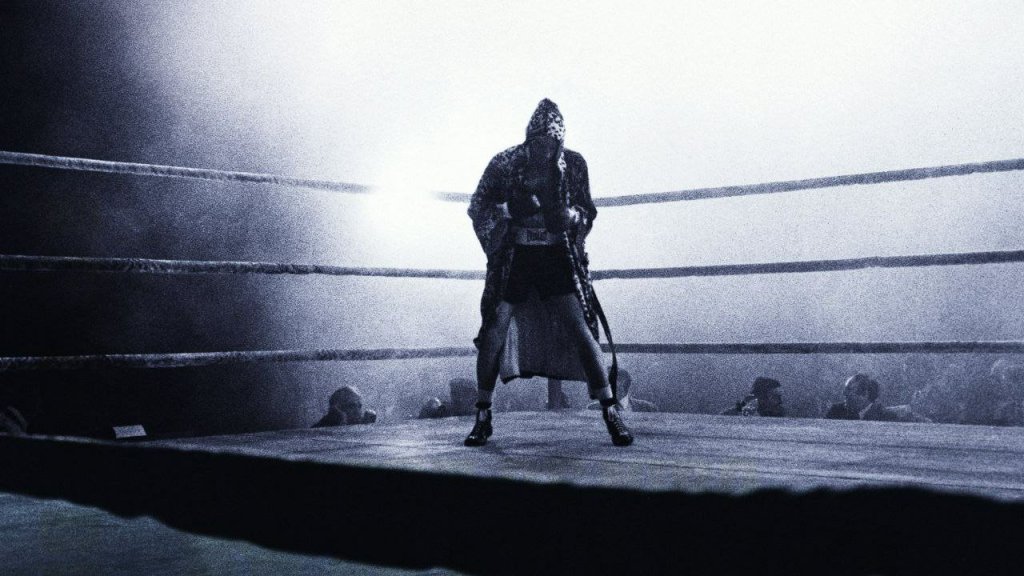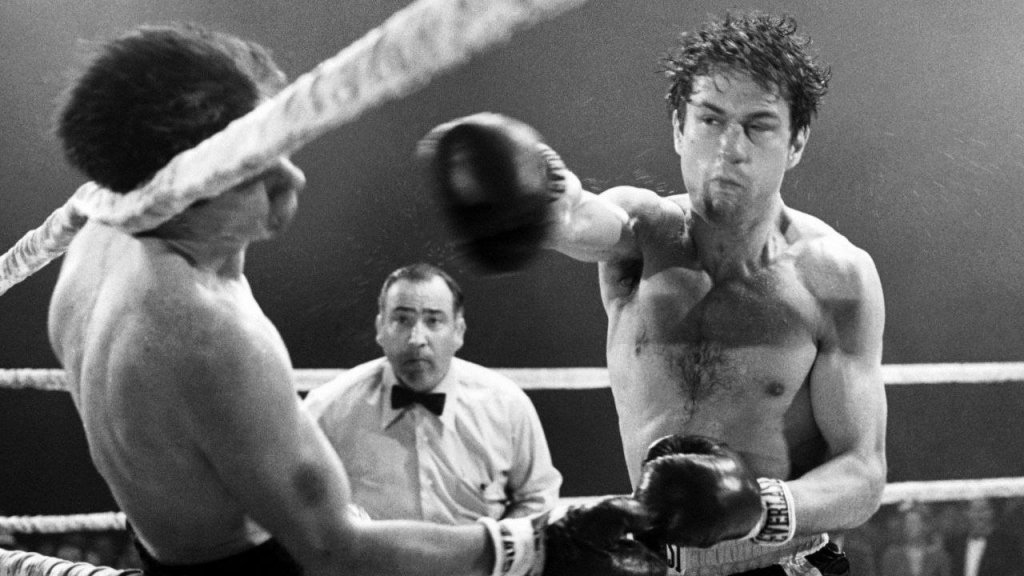“…I could’ve had class. I could’ve been a contender. I could’ve been somebody, instead of a bum, which is what I am…”

The collaboration between Martin Scorsese and Robert De Niro is one of the most prominent, if not the greatest in Hollywood. Their perpetual bond birthed exceptional movies like Taxi Driver (1976), King of Comedy (1982), Goodfellas (1990), Casino (1995) among others. One of their most famous collaborations is Raging Bull, a 1980 black-and-white biographical sport drama based on the life of Jake La Motta. Martin Scorsese’s Raging Bull follows the rise and fall of a boxer, Jake (played by Robert De Niro), a man one can only presume to be the enemy of himself.
The tumultuous life of Jake, on and off the boxing ring is vividly captured in this motion picture that depicts a brute who battles his way through the world of boxing to have a chance at a Championship match. But his strained relationship with those around him and reluctance to succumb to the desire of mob boss, Tommy Commo (Nicolas Colasanto), keeps him from participating in the Championship. Out of the boxing ring, La Motta’s life is a complicated one. He discards his old wife and gets married to 15-year old Vicky (Cathy Moriarty), and his greatest supporter is his trainer-brother, Joey (Joe Pesci), who he rarely listens to.
The movie flourishes as a result of Robert De Niro’s outstanding acting, one that earned him an Oscar in the best actor category that year. As we see the world of La Motta through De Niro’s eyes, we get to take in an actor who strips down to become a man driven by jealousy, rage and paranoia. The only time he is himself is in the boxing ring where he brutally punches his opponent, but the pride he derives from it is easily taken away when he colludes with the mob boss to have a chance to compete in the Championship. In the late 40’s, La Motta gets a shot at the Championship on the condition that he loses a fight against Billy Fox (Eddie Mustafa Muhammad). He does so terribly that an investigation is carried out shortly after, one which almost ends his boxing career. After two years out of the ring, he comes back to win the Championship title, which his famous arch-rival, Sugar Ray Robinson (Johnny Barnes) , relieves him of. There is a true honesty that comes with Robert De Niro’s performance in Raging Bull as he plays an unlikable protagonist, a megalomaniac whose mode of expression is only through violence.

Image via United Artists
Scorsese also used the biopic of Jake La Motta to depict how women are treated as sexual objects. With an aggressive relationship with his first wife and a paroxysmal romance with Vicky, Jake La Motta can only be considered as a man who uses his masculinity to inflict pain on the other gender. As Jake rages towards the path of self destruction, his character seems fuzzy everytime he continuously harms and harasses Vicky, the woman he shows he cares for and want to protect.
La Motta’s affinity for violence also reveals him to be a masochist— from the way he eggs Sugar Ray on to continue beating him; “you didn’t get me down Ray”, he says continuously, to pouring ice in his short to relieve himself of any form of sexual desire and to how he prods his brother, Joey, to punch him in the face. It could also be deduced from Joey’s personality that masculinity superiority runs in the La Motta’s family. As Joey tries to manage his brother’s iffy life, he also exposes himself to be just as vicious and barbaric as his brother. Robert De Niro’s future roles as Ace in Casino, Neil McCaulay in Heat and Al Capone in The Untouchables, show he was just the perfect person to play the role of Jake La Motta and no other person would have done it any better. Towards his impending doom, he makes his obsession and paranoia get the best of him thus alienating himself from his wife and brother. He becomes a shadow of his former self, a raging bull who tries to suppress his rage in the most ironic way ever, ending up as a comedian.

Martin Scorsese’s Raging Bull boasts reverberating sound effects that come with the punches and jabs that the fighters throw at each other by enhancing their severity. Overall, this helps set the mood of the fighting scenes thus making it more realistic and endearing. The boxing bout itself vividly brings in the bloody images of violence.
However, Scorsese’s use of black-and-white comes in handy to tone down the bloodshed which the fighters inflict on each other — which could also be a means of camouflaging the bloodshed and placing viewers’ attention on the characters and their exploits. The black-and-white picture also makes the movie timeless and distinguishes it from movies with a similar genre. The 1976 movie, Rocky, which won the Oscar for Best Picture comes to mind, a sports drama which propelled Sylvestre Stallone to Hollywood spotlight.
With an outstanding movie of this genre already in the minds of movie watchers, it was only unique and artistic of Scorsese to do the unexpected and separate it from other sports dramas of its time. Looking back after years of numerous sports dramas, most especially character-driven ones, Raging Bull is a brilliant portrayal of an egomaniac, and it is not just about the art of boxing but the tragic life of a skilled boxer whose only way of communicating is rage, and sadly, his downfall.
Rating: 8/10
Side Musings
- The fight between Jake La Motta and ‘pretty face’ Tony Janeiro was hilarious, I could feel the rage behind every punch La Motta landed on him. Followed by the mob boss’ droll comment on Janeiro’s messed up face, “well, he ain’t pretty anymore”, which was pretty amusing.
- Joey’s fight with Salvy and his friends at the bar was a comical one cos I laughed all through the scene.
- Pesci’s character in Raging Bull probably set the foundation for his future roles as a short-tempered person in Goodfellas and Casino.
Raging Bull is currently streaming on Amazon Prime Video.



1 Comment